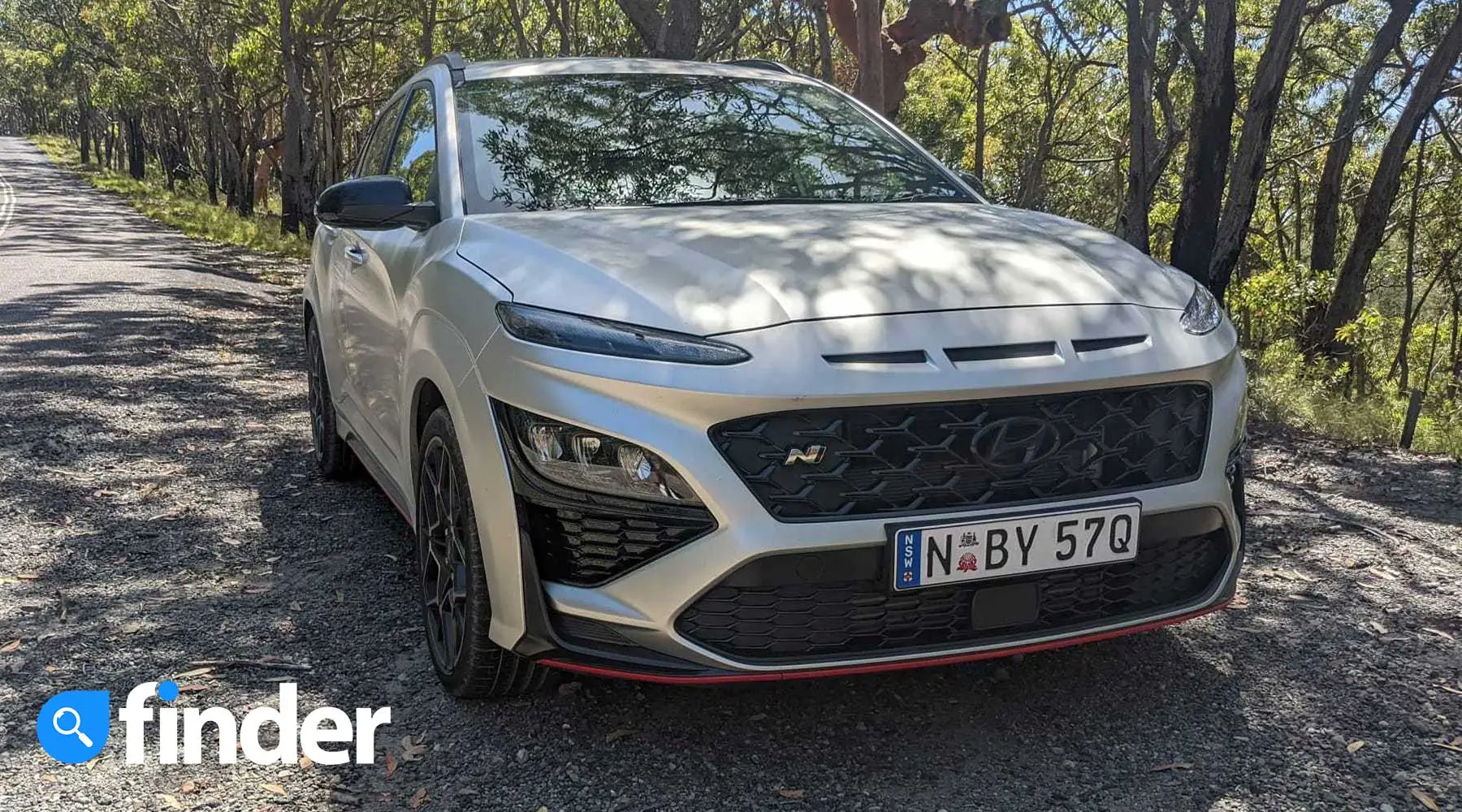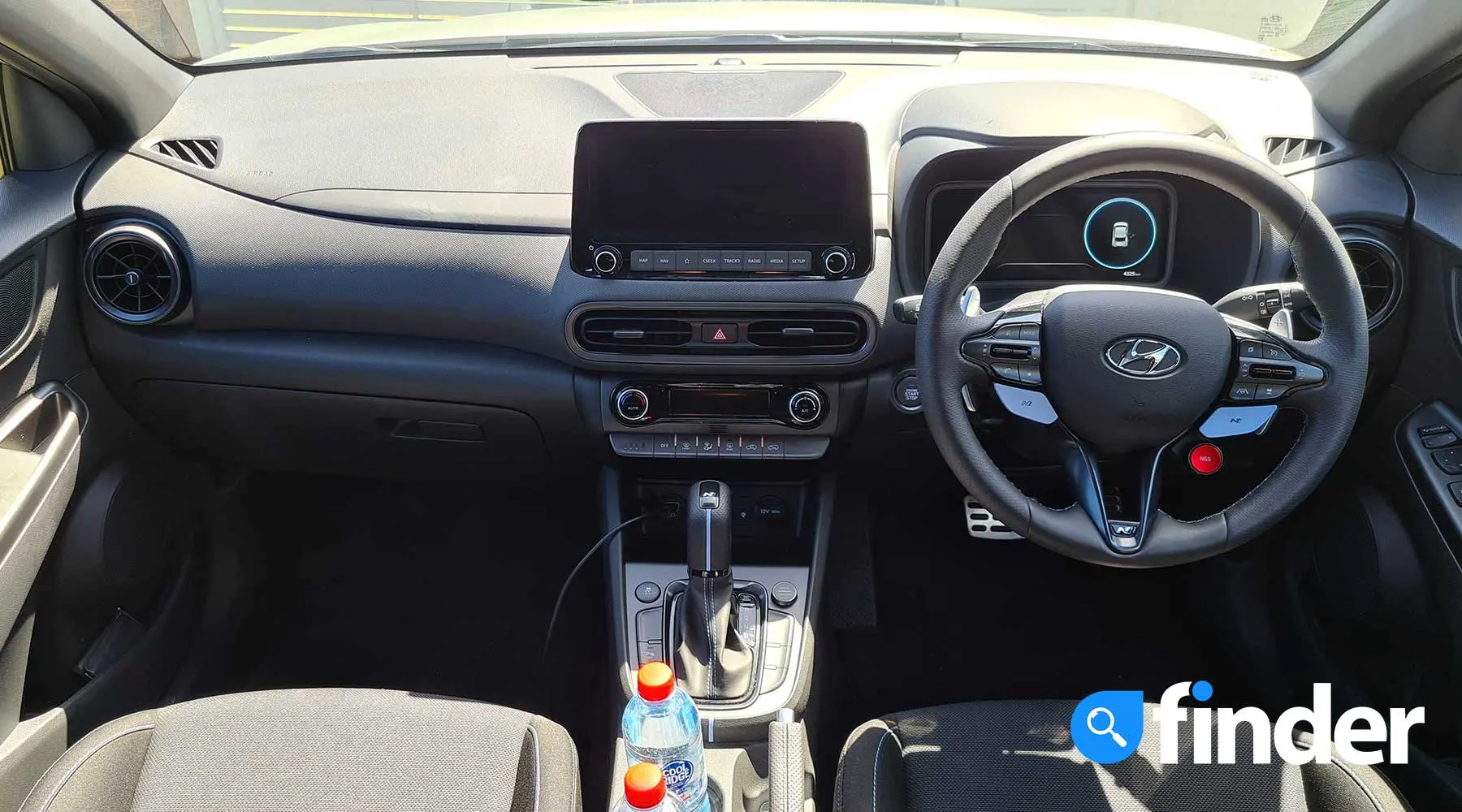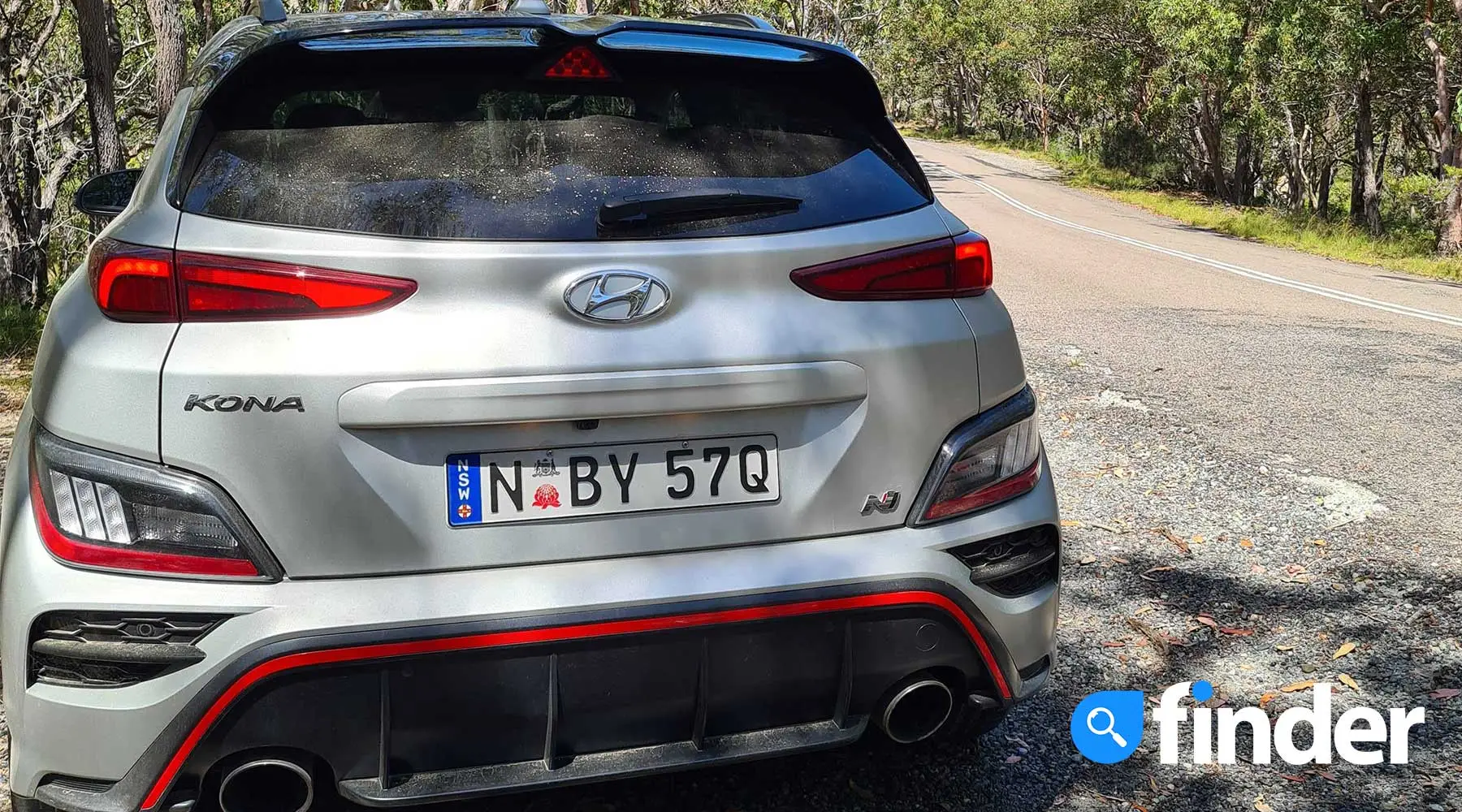This is the Hyundai Kona N. Under the bonnet is a 2.0-litre 4-cylinder turbo petrol engine that puts out 206kW the majority of the time (we’ll get to that later) and 392Nm.
With that sort of power, it can get to 100 in just 5.5 seconds.
What I am getting at here is that it is fast. But as you can see, it is also an SUV and, for those of you who follow the Fast & Furious franchise, I imagine this is the car that Dom Toretto will purchase when he is ready to settle down with a family.

The Kona N starts from $47,500 for the version you see before you, and goes to $50,500 for the Kona N premium. If you want this exclusive matte gold colour – which looks fantastic, the pictures don’t really do it justice – you’ll need to add another grand.
Essentially, at this price point it is currently in a class of its own at the moment, with no competitors hailing from anywhere except Europe.
It looks good, tell us about it…
I think this thing looks fantastic and that is a big compliment because, if I am being honest, I'm not a massive fan of the ICE Konas in anything other than this kit.
As part of the N look, you get 19” rims that are wrapped in Pirelli P Zero rubber and fresh body kit with blacked out badging up front which looks great when the cars have been dipped in this matte gold paint.
Other additions around the vehicle include a front-lip with a coloured insert and a split-channel spoiler sitting high on top of the hatch at the back which has an F1-style triangle brake light. Dual exhaust outlets and a rear diffuser round out the look – which really does transform the Kona.
As for the matte gold paint, you’d be forgiven for thinking it is silver as it is quite subtle, but in different lighting the gold comes out. It will set you back an additional $1,000 while metallic and Mica colours are $595.
What’s it like inside?
If you have driven or read reviews on any of the other N vehicles before, it is all quite familiar.
You get a nice leather wrapped steering wheel which is fairly chunky. It gives the vehicle a solid, sturdy feel and lets you know you’re in control of something that is a bit more substantial. There are your normal steering wheel controls and N button, but this also gets a red NGS button we will talk about later.
Bucket seats up front make sure driver and passenger feel supported and locked in place, while a manual handbrake adds to the experience of the Kona N being a truly performance-focused vehicle. Who wants an electric handbrake in a performance car?
A 10.25 inch screen sits above the dashboard and runs the standard software you find across the Hyundai and Kia products. It comes with Satellite navigation, DAB+, Apple Carplay and Android Auto as standard.

As you would expect from Hyundai, the screen is easy to use, responsive and has a crisp display. There are also some cool features in there like a new feature called Track Maps in the N section. Track Maps is basically GPS navigation for racetracks and as you get closer to a compatible track, you’ll get an alert and track configurations.
This one is already loaded with Sydney Motorsport Park and Wakefield Park in multiple configurations.
An 8-speaker Harman Kardon sound system has been installed for those audiophiles and you also get a Qi wireless phone charging bay.
The digital cluster is also 10.25 inches and easy to navigate on the go.
Press the N button and you get some more aggressive graphics for when you’ve got your foot buried through it.
There are 2 cup holders present up front, but they won’t hold anything larger than a 600ml plastic bottle. They won’t hold, for instance, a metal reusable bottle or a supplement shaker.
Single-zone air conditioning keeps the cabin cool, but won’t allow driver and passenger to have separate temperatures. There are no air conditioning vents in the back either.
Sitting in the back, things are a little tight, but we aren’t talking about a fully fledged SUV here, so that is to be expected. My knees pressed against the driver seat with it in my driving position (6 foot) and I found myself hitting my shins on the plastic map pockets on the back of the seat, which wasn’t fun.
There was a decent amount of headroom, but I imagine with an upgrade to the Premium that this extra headroom would disappear in favour of the sunroof.
You get 2 cup holders in the back and while you do get door bins, they aren’t the largest.
What extra do I get in the Kona N Premium?
If you fork out for the Premium version, you get extras like a heads up display, electric adjustment on the front seats and a sunroof.
I’m not sure you really need it, but for 3-and-a-half-odd grand difference, you do get a fair bit extra.
What’s the Kona N boot like?
The boot is capable of storing up to 361 litres which is smaller than the i30 that is rated at 381 litres. In terms of its European competitors, the space offered up by the 2022 Kona N is less than that of the Mercedes-Benz AMG GLA 35 which measures at 435 litres, but it does edge out the Audi SQ2 which has 355 litres available.
There is 1,143 litres available with the second row folded down.
Underneath the floor is a space saving tyre, which beats repairing a tyre on the side of the road.
What’s it like on the road?
To start with, the Kona is powered by a 2-litre 4-cylinder turbo petrol engine capable of producing in excess of 206kW and 392Nm, which gets converted into motion via an 8-speed dual-clutch automatic transmission.
You will note that I said “in excess of 206kW” and that is because the Kona N comes with a GRN mode which is essentially an overboost, producing an extra 7kW for up to 20 seconds.
Launch control in a Kona seems bizarre and foreign, but putting it in “N mode”, setting it up and then launching it is incredibly fun. With everything engaged, 5.5 seconds is all it takes for the Kona to get to 100km/h.

Sitting proud on the steering wheel is a big red N Grin Shift (NGS) button which just calls you to press it. Pressing this changes a bunch of different settings and drops you down to the lowest gear possible while also boosting power to 213kW for 20 seconds.
Once you’re up to speed, an electronically controlled limited slip differential helps get the Kona N around bends with the help of the grippy Pirelli P Zero rubber. It feels almost as if it is on rails and pretty far from what I was expecting, if I am being honest.
Especially when you consider that this isn’t 4-wheel drive and power is being distributed between the 2 front wheels, I was surprised with how controlled the Kona N felt through corners, and it gives you the confidence that you could push a little harder if you wanted to.
The chassis on the Kona N has been stiffened, meaning there isn’t the body roll you may expect, and it really does bolster the cornering ability of this compact SUV. Out in the real world, though, all this rigidity and tinkering has been at the compromise of some comfort.
Electronically controlled suspension takes things like driver input and road surface information from various sensors and can adjust damping up to 200 times a second. All the software has been tuned for Australian roads and theoretically it can make the car feel more sporty or comfortable depending on the settings.
I struggled to feel any meaningful difference between the modes, though – it felt firm and sporty a lot of the time.
For the average daily commute or motorway trip, there is plenty of power on tap and while the Kona N is no slouch off the mark, you do feel a healthy amount of speed come on in a thrust of turbo goodness.
Washing the speed off isn’t a worry either – with the sporty model of the Kona range getting uprated brakes, the front rotors measure 55mm larger than the standard model at 360mm. A track-focused variant wouldn’t be complete without some big red callipers either.
As it does bring the speedo back down, it will do so with smile-inducing cracks and pops with rev-matching like on other N vehicles before it, like the i30 N. What this does lack, though, is the option of a manual. In the grand scheme of things, given the category of the vehicle, that would just add that extra element of fun.
Rear parking sensors and reversing cameras help you park and manoeuvre the car and once you’re parked up you have the satisfaction of a manual handbrake, because let's face it, it isn’t going to get used for handbrake turns.
How safe is the Kona N?
Hyundai have fitted this brisk, compact SUV with its extensive SmartSenseTM safety suite as standard. That means it gets a whole host of passive and active safety features to help keep you off the phone with your insurer.
As standard, the 2022 Kona N gets:
- Blind-Spot Collision-Avoidance Assist
- Driver Attention Warning
- Forward Collision-Avoidance Assist
- High Beam Assist
- Lane Following Assist
- Lane Keeping Assist
- Rear Cross-Traffic Collision-Avoidance Assist
- Safe Exit Warning
- Adaptive Cruise Control
In addition to this, you have 6 airbags throughout the cabin should something go awry.
What is warranty and ownership like?
Hyundai covers the 2022 Kona N with a 5-year unlimited kilometre warranty and capped price servicing plan.
Services are every 10,000 kms or 12 months, whichever occurs first, and each service is $335.
- 12 months / 10,000kms – $335
- 24 months / 20,000kms – $335
- 36 months / 30,000kms – $335
- 48 months / 40,000kms – $335
- 60 months / 50,000kms – $335
Service also included updates to the satellite navigation up to a maximum of 9 updates.
Verdict
At $47,500 this Kona N is probably the pick over the Premium. The inclusions help to justify the price, but the compromise on space, especially if you are carting around taller people, isn't worth it in my eyes.
From a performance perspective, you wouldn’t regret choosing this over an i30 N and if you were already looking at the Kona, it easily justifies the $5,100 premium over the N-line premium model below it.
Normally we might position this against a competitor at this stage as a way to gauge whether this is a value purchase, but it is more or less in a class of its own at this point in time in Australia.
Looking at the SQ2, for instance, this is down on power by 15kW. It has a larger boot than its European counterpart, though, and costs $16,900 less.
The Mercedes, on the other hand, has 19kW more and a larger boot, but costs a staggering $91,888.
So the main thing you need to think about is: If Dom Toretto would buy one, maybe you should consider it too.
Check out our car reviews which compile multiple reviews into one, helping you save time when researching your next car. You might be surprised how much you could save by comparing car loans and car insurance.
More guides on Finder Shopping
-
Hyundai Ioniq 5 N Review
The future’s electric – and it wants to burn rubber
-
2025 Genesis G70 Review
It's faster than a BMW 3 Series, more unique than a Mercedes C-Class and loaded with features that make it feel every bit as premium.
-
Volkswagen Golf Mk8.5: More tech, more power, more excuses to upgrade?
The VW Golf is back - and it's got more of everything.
-
Sharper, smarter and better value: The 2025 Skoda Octavia RS lands in Australia
Skoda refines its family-friendly performance car with more features, more power and a competitive price.
-
2024 Peugeot E-Expert Van Review
Peugeot have made a van that whispers while it works.
-
2024 Toyota GR Corolla review
Toyota gave a Corolla muscles and a megaphone and it’s glorious.
-
2024 Jeep Wrangler Review
Born for the trail, adapted for the tarmac
-
SUV reviews
Let us assist you in picking your next SUV.
-
Best small cars
There are dozens of different makes and models to choose from and then about five different trim levels on average, per carmaker. This guide will help you cut through the sales banter.
-
Electric Car Reviews 2025
Which electric car should you buy in 2021? Find out with our complete EV guide.
